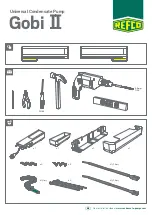
!
WARNING
To avoid risk of electrical shock, personal injury, or death, disconnect electrical power source to unit and
discharge capacitor through a 10,000 ohm resistor before attempting to service, unless test procedures require
power to be connected. Ensure all ground wires are connected before certifying unit as repaired and/or
operational.
©2003 Maytag Appliances Company
16022379 Rev. 0
13
Low Voltage
Low voltage can result in one or more of the following
problems:
• Unit will not operate.
• Compressor motor cycling.
• Premature failure of overload protector.
• Frequent blown fuses or tripped circuit breakers.
• Premature failure of compressor or fan motor.
• Noticeable dimming of lights when unit is operating.
Common causes for low voltage include inadequate
supply circuit wiring; use of extension cords; and
loose fuses or connections in fuse box, circuit
breaker, or distribution panel.
NOTE
: A good indication of voltage problems caused
by inadequate or faulty wiring is voltage
levels that do not remain constant under load
(supply voltage fluctuates).
A less common cause for low voltage is voltage from
local electric utility is low (sometimes called “brown
outs”). If this is the case, have consumer contact
local electric utility for assistance.
All units should operate normally if power stays within
specifications (refer to Technical Sheet for unit under
test). Test for low voltage using voltmeter. Verify
voltage level at circuit breaker/distribution panel for
unit under test, and at electrical outlet serving unit.
Take initial voltage readings with air conditioner
turned off. Take additional readings during start-up of
unit, and again while unit is operating. All readings
should be within specifications and remain constant.
NOTE
: Supply voltage may drop momentarily during
initial start-up and when compressor first
starts, but should always remain within
specifications.
High Voltage
High voltage causes motors to overheat, cycle on
their protectors, or break down electrically. This
problem can only be solved by local electric utility.
Testing Capacitors
Compressors in these units use permanent split
capacitor type motors, eliminating need for start
capacitors and relays. A low capacitance
“compressor run capacitor” assists during start, and
remains in system during operation. See directions
on capacitor, and wiring diagram (on Technical
Sheet) for unit under test.
Capacitors are also used on permanent split
capacitor (PSC) fan motors.
To test capacitors:
1. Disconnect power to unit.
2. Discharge capacitor by shorting capacitor
terminals through a 10,000 ohm resistor.
Disconnect leads attached to capacitor terminals.
3. Set ohmmeter on highest scale. Attach ohmmeter
leads to capacitor and observe ohmmeter display:
•Good condition—indicator swings to zero and
slowly returns toward infinity.
•Shorted—indicator swings to zero and remains.
•Open—indicator does not move.
4. Reverse ohmmeter leads on capacitor and repeat
step 3.
Checking Overload Protectors
Overload protectors protect compressor from current
and temperature overloads by removing power from
compressor before it is damaged.
To check overload protector:
1. Disconnect power to unit.
2. Remove overload lead from compressor terminal.
3. Use ohmmeter to test continuity between overload
terminals. If open, replace overload.
Checking Compressor Windings
Resistance Test
1. Disconnect power to unit.
2. Remove leads from compressor terminals.
3. Set ohmmeter to lowest scale.
4. Attach ohmmeter to compressor terminals C and
S.
Note reading.
5. Attach ohmmeter to compressor terminals C and
R. Note reading. If either compressor winding
reads open (infinite or very high resistance) or
dead short (0 ohms), replace compressor.
Testing Procedures
Summary of Contents for AAC051FRB
Page 24: ...2003 Maytag Appliances Company 16022379 Rev 0 A 1 Appendix A...
Page 43: ...19...














































